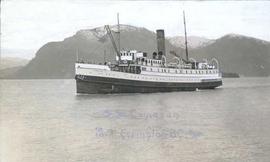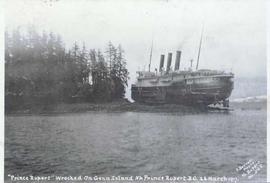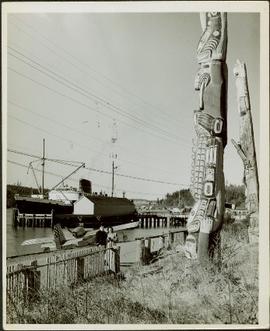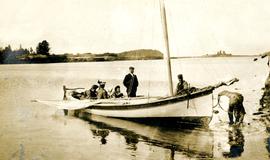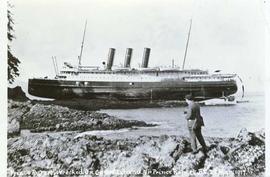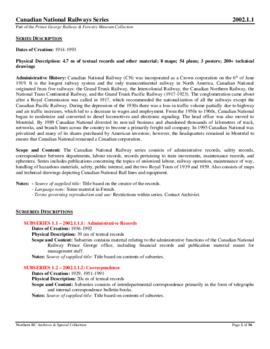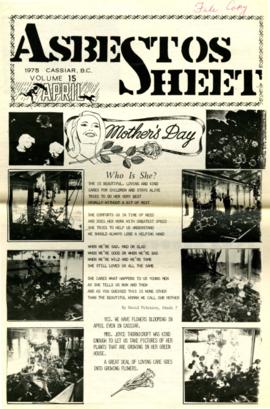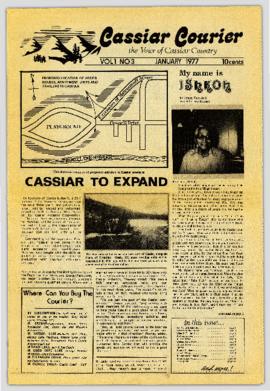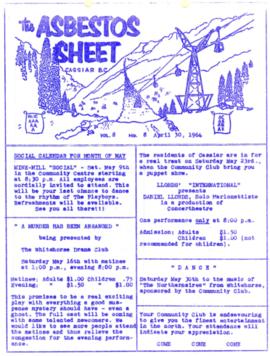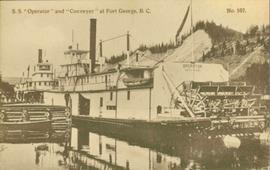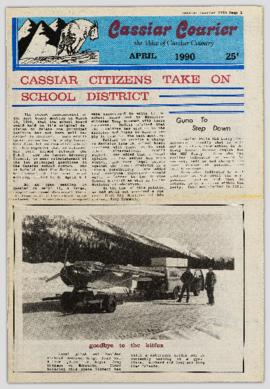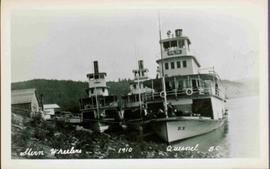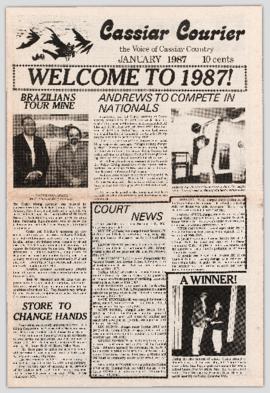File consists of Campagnolo's incoming and outgoing correspondence in French and English regarding the development of tourism in British Columbia. Also includes a promotional folio on Panorama Mountain Resort in Windermere British Columbia, resolutions in French from the Chamber of Commerce of the Province of Quebec concerning tourism, excerpts from a magazine article on foreign tourism, photocopied newspaper clippings, a proposal for a school ship program on the west coast, a report entitled "The New Look for B.C. Steamships," telexes, and notes.
Photograph depicts the steamship Camosun on the water with a mountain range in the background. Annotation on recto of photograph states: "S.S. Camosun Port Essington B.C." Annotation on verso of photograph states: "Canada B.C. The Coast Steamer "Camosun" passing Port Essington"
Photograph depicts the steamship Prince Rupert run aground on a rocky shoreline beside a forested area. Annotation on recto of photograph states: ""Prince Rupert" Wrecked On Genn Island Nr Prince Rupert B.C. 23 March 1917. F. Button Photo Pr. Rupert No.568"
Photograph depicts a man in uniform and a woman posing for a photo on a road situated between a fenced area featuring totem poles. Along the water’s edge in the background there is a float plane, wharf and the Camosun vessel. Handwritten annotation on verso reads: “Alert Bay B.C. Union Steamships Ltd.”; “Alert Bay BC”; photographer’s stamp on verso states: “W.E. Nicholson, 268 E. 10th, Vancouver 10, B.C.”
This file consists of 32 photographs pertaining to the Yukon steamship Tutshi, ca. 1936 and J.J. Claxton’s time aboard the Columbia Cost Mission Ship M.S. Columbia III, ca. 1960. General subject areas identified in these photographs include: individuals and communities visited by the Columbia III; families involved in receipt of pastoral services such as marriages and baptisms; as well as medical care.
Rev. William Edwin Collison stands in centre of boat, with wife Bertha and daughters Muriel and Katherine seated behind. Unknown man and woman are also seated in boat, and an unknown man stands on shore holding rope.
Handwritten annotation on verso reads: "Will Collison with wife & children leaving Metlakatla to catch steamship en route to England (1910)".
Audio recording is of an interview by Bridget Moran with both Mr. George Henry and Mr. Arnold Davis to discuss their memories of the early town site development of South Fort George and Central Fort George c.1910-c.1917. Mr. Henry was born in 1882 and his family arrived in Quesnel in 1909. Mr. Henry’s interview is primarily about his work as a captain on the BX Sternwheeler up until the time of the railroad arriving in Prince George in 1914. Mr. Davis, who was a Sherriff in Prince George, recalls his childhood memories of Fort George and Central Fort George c.1917. Mr. Davis also discusses his family roots from Ireland, the family’s arrival in Fort George from Ashcroft in 1917 and memories of his father who worked on the sternwheelers on the Fraser River.
Audiocassette Summary
Scope and Content:
Interview with Mr. George Henry
Mr. Henry was born in 1882 in Northern California and his family came to the Cariboo in 1909. He recalls riding his bicycle from Ashcroft to Quesnel in 3 days to find work with the BC Express Company.
Mr. Henry recalls working on the BX and describes the sternwheeler trip from Quesnel to South Fort George; it was a 3 hour trip from Quesnel and included two mail stops ;
Henry recalls an accident onboard the sternwheeler going through the Fraser Canyon (see p.p.11-12 of
Prince George Remembered)
Mr. Henry describes his homestead at South Fort George
Mr. Henry describes the BX sternwheeler being aground at South Fort George c.1920
Mr. Henry recalls spending winters in South Fort George in his log cabin; that work was “plentiful” in 1910 and the population at “about 700”
Mr. Henry notes that the “Indian reserve was at the Hudson’s Bay company” and that the native population was at “about 50”
Mr. Henry recalls the early commercial businesses in South Fort George c.1910 including the Northern Hotel; the candy store and ice cream store and theatre.
Mr. Henry describes the start of the town site of Central Fort George as a “viable little town” which started once the Grand Trunk Railway arrived and recalls the change in population between South Fort George & Central Fort George.
Henry recalls how all the workers came and lived in tents in Central Fort George.
Mr. Henry was not happy about the arrival of the railway as it meant he lost his job on the sternwheeler – he recalls that “us old river rats were just lost” (see p.p.34 of Prince George Remembered)
Bridget then asks Mr. Arnold Davis to recall his memories of early South Fort George
But first asks him to describe his family’s roots (See p.p. 1-2 of Prince George Remembered)
Scope and Content:
Interview with Mr. Arnold Davis
Davis notes he is 6th generation Canadian; family came from Ireland and his grandfather’s brother Jeff Davis became the President of the Confederate States of America.
Davis refers to his mother’s family being on the Prairies at time of the trial of Louis Riel
Davis explains that his grandfather first homesteaded at Banff; then Kamloops; then Ashcroft and on to South Fort George in 1917.
Davis’ father worked for the BC Express Company and he recalls being on the sternwheeler as a child during same time that George Henry worked the boats. Recalls workers on the boat; eating pie on the boat baked by the Chinese cook; (See p. 33 of Prince George Remembered)
Davis recalls the town site of South Fort George. He notes it had a population by 1917 of only “about 300” and that the “boom was over”
Davis describes location of various businesses in South Fort George including the Rex Theatre, George St. Poole Room, McKay Bros. Grocery store, Drugstore, Bairds, Peters Butcher Shop.
Davis recalls that there were many “Yukoners” here at the time and recalls a tale about an old Yukoner
Mr. Davis recalls other people who worked on the BX with his father including Margaret “Granny” Seymour’s father;
Mr. Davis recalls riding up and down the river to Foley’s Cache on the sternwheeler as a child
Mr. Henry then speaks up and recalls trips on the sternwheeler with Arnold Davis on the boat as a child
Tape ends
File consists of material relating to William John "Wiggs" O'Neill, a riverboat pioneer. Wiggs began working on a Skeena River sternwheeler in 1898 and continued working on the river until the end of the steamboat era in 1911. He then moved to Smithers, where he operated the first power plant and owned an auto agency for 43 years. Materials include two books, newspaper clippings, and reproductions of journal articles. Highlights include:
- Wiggs O'Neill, "Steamboat Days on the Skeena River British Columbia", 1963 (book)
- Wiggs O'Neill, "Whitewater Man of the Skeena", 1960 (book)
File consists of Campagnolo's incoming and outgoing correspondence regarding federal financial assistance for ferry services in northern British Columbia, and the termination of Northland Shipping services. Also includes a news release concerning the withdrawal of funds to Northland Shipping Company Limited, a statement by Campagnolo concerning alternate passenger services to northern British Columbia, newspaper clippings, a chronological list of Northland subsidies, a summary report entitled "Summary of Northland's Ten-Year Study," a draft news release concerning alternate shipping services, a photocopied article entitled "Whistle up the Inlet: the Union Steamship Story," excerpts from "Ideas" newsletter with an article entitled "Ahousaht Freight Service," notes, telexes, telegrams, and a memorandum.
Photograph depicts a man standing in front of the steamship Prince Rupert run aground on a rocky shoreline. Annotation on recto of photograph states: "Prince Rupert" Wrecked On Genn Island Nr Prince Rupert B.C. 23 Mar' 1917. F. Button. Photo Pr Rupert No. 573" Annotation on verso of photograph states: "Dear Ted.- I am just writing you a note to remind you you have not written me since the last time. This is the way the Rupert is now she sure looks fine. I had a fine time in Rupert during the holidays. I wish you would send me some stamps. I traded Willie quite a few and two dandy, Montenegro ones. I am using my fountain pen now, it writes fine. I guess I will close your loving brother Gordon"
This document is an unpublished draft manuscript of a Northern British Columbia history annotated bibliography. The document is based overwhelmingly on research into secondary sources published prior to 2016; more recent sources are not included. The annotated bibliography includes the following sections:
- Historiography
- Settlement Histories
- Alexander Begg's History of British Columbia
- R.E. Gosnell
- E.O.S. Scholefield
- Regional History
- New Histories
- Environment
- Northern History
- Ancient History
- Bibliography
The Canadian National Railway series consists of administrative records, safety records, correspondence between departments, labour records, records pertaining to train movements, maintenance records, and ephemera. Includes publications concerning the topics of unionized labour, railway operation, maintenance of way, handling of hazardous materials, safety, public interest, and the two Royal Tours of 1939 and 1959. Also consists of maps and technical drawings depicting Canadian National Rail lines and equipment.
Canadian National RailwayFile consists of notes, clippings, and reproductions relating to the Cariboo and Northwest Digest publication. Also includes a CD-R that contains Sedgwick's index spreadsheet and accompanying documentation about the publication.
File consists of documents relating to the construction of the Pacific Great Eastern Railway (PGE), which predominantly consist of photocopy reproductions, excerpts from books, and clippings from periodicals. Includes a chronology of the history of PGE, a list of sub-contractors who completed the Squamish sub-division, "PGE/BCR: Dease Lake Extension First 25 Years, 1968 to 1993", and "P.G.E.R. 1914 to 1923: Progressive Dates of Commencement of Passenger Service".
"The Asbestos Sheet" is a newspaper that documents the community and work life of the residents of Cassiar BC. Content includes text and photographs, as well as jokes, comics, and games.
"The Cassiar Courier" is a newspaper that documents the community and work life of the residents of Cassiar BC. Content includes text and photographs, as well as jokes, comics, and games.
Fonds consists of records relating to the personal, business and political life of H.G.T. Perry and as such, has been divided into the following four series: 1) Photographs; 2) Political Activities; 3) Business Ventures; 4) Personal Life; and 5) Miscellaneous Historical Information Files. Also includes material relating to his son, Frank Perry, and his failed political campaign. Includes World War II and Post-War printed materials.
Types of records included in this fonds include Speakers' Decisions (1877-1943) in the BC Legislative Assembly, maps, publications, reports, correspondence, advertisements, telegrams, resolutions, minutes, annual reports, telegrams, resolutions, reports, speeches, press releases, proposals, plans, charts, file notes, memoranda, newspaper clippings, scrapbooks, ephemera, postcards and photographs.
Perry, Harry G.T."The Asbestos Sheet" is a newspaper that documents the community and work life of the residents of Cassiar BC. Content includes text and photographs, as well as jokes, comics, and games.
Postcard photograph depicts two sternwheelers in dock. Group of men can be seen standing on dock. Steep banks of opposite shore visible in background.
Printed annotation on recto reads: “S.S. “Operator” and “Conveyer” at Fort George, B.C. No. 107.”
Audio recording consists of individual taped interviews conducted by Bridget Moran with a number of early Fort George residents recalling the early years of white settlement in Prince George c.1910-c.1915. Interviews were conducted with the following individuals: Arnold Davis; J.A.F. Campbell; Alec Moffat; Claude Foot; George Henry; Nellie Law; John McInnis; Georgina [McInnis] Williams and Peter Wilson. These interviews were incorporated into the publication: Bridget Moran, Prince George Remembered…from Bridget Moran, Marsh Publishing, Prince George, 1996.
Audiocassette Summary
Scope and Content:Recording consists of individual taped interviews conducted by Bridget Moran in a number of locations with Arnold Davis; J.A.F. Campbell; Alec Moffat; Claude Foot; George Henry; Nellie Law; John McInnis; Georgina [McInnis] Williams; Peter Wilson
Subjects include:
- Arnold Davis – former Sherriff in Prince George (born in 1882) arrived in Quesnel in 1909 and worked on the BX sternwheeler. Davis discusses his family roots from Ireland as a 6th generation Canadian. Recalls how his family arrived in South Fort George in 1917 and how his father worked on boats that went up and down Fraser River
- Claude Foot recalls coming from New Zealand to Fort George [Prince George] in 1906 and how there were ‘very few white men’; his father was Irish, mother was English
- Alex Moffat – describes how his parents provided a ‘stopping place’ for stage coaches in the Cariboo region
- George Henry recalls working on the boats that plied the Fraser River between Prince George and Soda Creek, near Quesnel
- Nellie Law – describes arriving from England in 1917 to Ashcroft and then Quesnel in 1917
- Peter Wilson – Barrister and Solicitor; the prosecutor for Prince George since 1916 describes arriving by train from Edmonton and arriving on a scow in South Fort George
- Mr. John McInnis – from Prince Edward Island, who sat twice in provincial legislature – in constituency of Grand Forks as socialist and later for constituency of Fort George recalls arriving in 1910 by rail to Kamloops and then by sleigh to South Fort George; describes the Indian Reserve at Fort George “[…don’t think there were a dozen white people…when I arrived […]”
- J.A. ‘Doc’ Campbell recalls being part of a survey crew in Fort George in 1908
- George Henry – also recalls cruising down the [Fraser] river by way of sternwheeler and losing men overboard
- Peter Wilson recalls experiences as practicing lawyer; there was no assize court in the region until 1919; recalls some of his early cases [murder case]
- Nellie Law describes working as a desk clerk at first The Alexandra Hotel and later The Prince George Hotel from 1918 to 1952
Law describes the hotel patrons and how she met the Duke and Duchess of Devonshire in 1922. Recalls stoking furnace with logs in the hotel to keep it warm and working as a bouncer - Alex Moffat – recalls workers and hauling freight via the old Cariboo Road; existence of one policeman only (BC Provincial Police); and describes in detail a stopping place for horses / crew on the Cariboo Road and the pack trains.
- Mr. Moffat – Describes the luxury experienced on the sternwheeler, The BX that “could carry seventy saloon passengers” and “staterooms were all equipped with push buttons, electric lights, hot and cold water, steam heat, and everything modern”
- Claude Foot – Recounts a dance in Quesnel at the hotel barroom and describes ordering drinks at the Al Johnson Hotel that had a bar which boasted to be “ the biggest bar in Canada, if not the world” 100 ft + bar with “six or seven bartenders behind this long bar, and the customers would be lined up two or three deep […]”
- J.A. [F.] [Campbell] – post-1910 changes with the use of scows on the Fraser River; describes the BC Provincial Police “in those days [they] just wore ordinary civilian clothes, but they were a tough bunch….[…]” and rowdiness in the bars in South Fort George
- Campbell describes the first bank in Fort George was the Bank of British North America that was housed in a tent and he recalls needing money while playing poker - ‘about eleven o’clock that night, the vault was open, and the till was open, and if you wanted money you’d walk up to the bank till and put an IOU in and take money out and go on playing [poker]
- Peter Wilson – comments about how lax the enforcement of law and order was in the early years including among the police themselves: “that the “Old Blind Nick [who] ran a bootlegging joint, went broke because he said he couldn’t afford to supply the police with any more liquor.”
- Claude Foot – recalls a fire in Quesnel in 1916 that burned a large part of the business section and the firemen were as Nellie Law notes “ a bucket brigade of Chinamen, filling buckets from a water hole in the Fraser River that the horses drank in…”
- John McInnis recalls political meetings and the election in 1916 when he was a candidate for the Fort George riding and being defeated by 7 votes; that the investigation of the election “was a whitewash”
- Georgina McInnis, who was the first White Child born in the community – she tells of the meeting that decided her name – as Fort Georgina McInnis
- Arnold Davis recalls his father working on boats that went up and down Fraser River and being on the boat with him and “watching the connecting rods go in and out and concentrate on pie…[served by the Chinese cook]” Davis also recalls The Yukoners who emigrated to PG after the Gold Rush
- George Henry recalls with lament the coming of the railway as he lost his job plying the River - preferred voyages on the Fraser River – and refers to those who worked the River and himself as “river rats”
"The Cassiar Courier" is a newspaper that documents the community and work life of the residents of Cassiar BC. Content includes text and photographs, as well as jokes, comics, and games.
Photograph features three sternwheelers tied to river bank. Buildings visible on far left, hills on shore visible in background.
Printed annotation on recto reads: “Stern Wheelers 1910 Quesnel B.C.” Handwritten annotation on verso in pencil reads: “BX, B.C. Express, Charlotte”
"The Cassiar Courier" is a newspaper that documents the community and work life of the residents of Cassiar BC. Content includes text and photographs, as well as jokes, comics, and games.
File consists of the following articles and speeches written by Knox McCusker:
- "Reminiscences of Knox McCusker" (63 typewritten pages)
- "Back and Beyond the Peace" by K.McCusker (taken from the Toronto Star Weekly Saturday May 5, 1928) – retyped
- "The Alaska Highway" by Knox F. McCusker, D.L.S. (The Canadian Surveyor, July 1943)-photocopy
- Mr. McCusker's speech (5 pages)
- “Tropical Valleys of B.C.” (4 pages)
- "The president has called me an old old surveyor…" speech written by K. McCusker
- "In the early days of my career in the Surveying profession…" written by K. McCusker
File contains speeches, background material, ephemera and correspondence. Includes:
- Unidentified speech re: coincidence of U.S. and Canadian elections
- Unidentified speech re: women in politics
- Speech by Iona Campagnolo (in French, believed to be to luncheon organized by La Commission Libéralé Féminine)
- Speech by Iona Campagnolo to the Western Arctic and Inuvik Liberal Association (handwritten, undated)
- Speech by Iona Campagnolo to the People of Central Nova (undated)
- Speech by Iona Campagnolo to the Annual Meeting of the Ottawa - Carleton Liberal Association (undated)
- Speech by Iona Campagnolo to “Liberals”: “Fast forward or full stop: is self-renewal possible?”
- Unidentified speech by Iona Campagnolo
- Notes for introduction of Mr. Trudeau to the Liberal Party of Canada (Quebec) Biennial Meeting by Iona Campagnolo (in French)
- Personal correspondence and newspaper headline (“Campagnolo urges nuclear freeze”) from Ivana to Iona Campagnolo re: support
- Pages 2-4 of unidentified, undated annotated speech re: Timmins, O.N.
- Christmas card to Iona Campagnolo from Jean M. (in French), undated
- Notecard to Iona Campagnolo from André Mylie (?) re: thank you for gift, undated
- Handwritten card featuring Gallup Poll figures: “% Female Vote” intermittently from 1962-1980 across the Canadian political spectrum
- Annotated page #23 of unidentified speech re: her presidency, ca. 1986
- First page of correspondence to Iona Campagnolo from unidentified woman from the Edmonton Women’s Network, re: Network operations and personal update, April 16, 1981
- Unidentified, handwritten speech re: war and peace
- Draft, handwritten speech - unidentified, undated, incomplete (2 pages) re: “For Sapher, title… “and keep your powder dry!”
- Page 11 of an unidentified speech re: reinvigoration of Liberalism, ca. 1985
- Unidentified handwritten speech re: “Focus on Success: Women of the 80’s”
- Page 3 of an unidentified speech re: to “play”
- Speech by Iona Campagnolo to the Alberta Teacher’s Association re: fitness and children (undated)
- “Diagram for I. Campagnolo Feb. 28 / speech” featuring heart rate target zone.
- Unidentified Itineraries for travel by Iona Campagnolo, Muriel Kergin and Tom and Helen each over Christmas holidays
- Notes on the Ryan Proposals, “A New Canadian Federation”: Part II: Details by Eugene Forsey (13 pages)
- Acknowledgment from The Salvation Army re: receipt of monetary contribution received in memoriam of Senator J.J. Greene
- Partial annotated speech by Iona Campagnolo to “Women’s World ‘88’” (pages 5-8)
- Page 7 of unidentified speech “The whole gamut of equity, of every human being having access to a better life”
- Two pages of unidentified speech re: gender and politics
- Quote by Frederick Douglas re: women’s rights
- Funny story: “Canadians”
- Nine page opening address to National Officiating Conference, ca. post 1976
- Notecard to Iona Campagnolo from Betty Lipingwell (?) re: thank you (undated)
- Handwritten notes re: sport, ca. 1978
- Photocopy of two photographs featuring Iona Campagnolo holding skating bag
- Two pages of an incomplete speech re: Iona Campagnolo’s opinion on women in politics and sport in Canada, ca. 1978
- Page 708 of Fitness and Amateur Sport Act, Fitness and Amateur Sport Regulations, P.C. 1962-920
- Page 35 of ‘confidential’ paper re: sport, ca. 1979 (?)
- Letter to Iona Campagnolo from Ed Broadbent re: agreement with Doug Fisher (undated)
- Letter to Iona Campagnolo from William Burnham (?), M.P. re: congratulations on article in The Sun and The Gazette (undated)
- Handwritten note to Iona Campagnolo (?) from (?) re: support (undated)
- Birthday invitation (Raggedy Anne) to a party for Marc (?), on July 24
- Seating arrangement for Council Table during the Installation of the Governor General, ca. 1978
- Page 7 of an unidentified, undated speech re: “Canada must grow together”
- Page 2 of a letter to an unidentified individual from Iona Campagnolo re: update on current affairs and visit by Juan Samaranch and the International Olympic Committee considering Calgary for Olympic bid (undated)
- Three blank postcards featuring Northern British Columbia wildlife (beaver, brown bear and wolverine)
- One blank postcard: “#6 Ghosts of ’98 Series: Sternwheeler Graveyard”
- One blank postcard: “Hong Kong Hilton” (includes two sheets of blank hotel note paper)
- Miscellaneous photocopy (?) of “very old Chinese proverb” written on oversize paper in calligraphic style *SEPARATED SEE “OVERSIZE BOX #35”
Reel-to-reel audio recording consists of individual taped interviews conducted by Bridget Moran with a number of early Fort George residents recalling the early years of white settlement in Prince George c.1910-c.1915. Interviews were conducted with the following individuals: reel to reel recording of individual taped interviews and interview introductions by Bridget Moran with the following interviewees: Arnold Davis [former Sherriff for Prince George]; J.A.F. Campbell [PG land surveyor]; Alec Moffat; Claude Foot; Captain George Henry [sternboat captain]; Nellie Law [desk clerk at Alexandra and Prince George Hotel from 1918- 1952], John McInnis [former MLA for Fort George]; Georgina [McInnis] Williams; and Peter Wilson, [former Barrister and Solicitor and former Prosecutor for the City since its incorporation in 1915.] These interviews were incorporated into the publication: Bridget Moran, Prince George Remembered…from Bridget Moran, Marsh Publishing, Prince George, 1996.
Summary
Notes: Recording consists of individual taped interviews conducted by Bridget Moran and commentary by Moran that introduces each audio segment. Recording is exact copy of the written transcript later produced as the publication, Prince George Remembered…From Bridget Moran, Prince George: Marsh Publishing, 1996. In the publication foreword, Moran notes that she recorded the interviews on reels, then re-copied them on cassette tapes, and for the book project based on the recordings she did the edits and provided the introductory remarks for each interviewee’s audio segment.
See also the audiocassette summary for 2008.3.1.210.4 “History of Prince George”. The reel to reel recording is incomplete as it includes recorded interviews only for 61 minutes, not the full 80 minutes referred to in the audiocassette summary for 2008.3.1.210.4. The reel to reel recording continues only to the end of Claude Foot’s description of the bar at South Fort George [see transcript, Prince George Remembered… From Bridget Moran, p.25]
00’ 05”-5’00” Arnold Davis– talks about his family’s roots from Ireland and England and arriving in South Fort George in 1917;
5’10”-10’11” Claude Foot – talks about his family’s roots in New Zealand and memories of arriving in Quesnel in 1906, “very few white men”
10’12”-11’08” Alex Moffat – describes stage coach transportation throughout the Cariboo region
11’24”-12’33” George Henry describes working on the boats that plied the Fraser River with the BC Express Co.
13’17”-14’14” Nellie Law describes arriving in Quesnel from England in 1914 and later arriving in Prince George on the Fraser River in 1917. Law was the desk clerk at Alexandra and Prince George Hotel from 1918-1952.
14’45”-15’09” Peter Wilson describes arriving by work train to Prince George from McBride c.1915. Wilson was the Prosecutor for the City since its incorporation in 1915.
15’48”-20’02” Mr. John McInnis recalls arriving from Prince Edward Island in 1910 in Fort George due to the land prospecting for the town site. Describes 10 day horse & sleigh trip from Ashcroft to Fort George and briefly describes Indian Reserve in Fort George and recalls there were few white women in the town at that time.
20’25”-22’05” J.A. Campbell describes survey crew work he did at Fort George in 1908
22’16”-25’36” Captain George Henry recalls cruising down the Fraser River with a gas-powered boat c.1910 and losing crew overboard in the Fraser Canyon
25’47”-33’20” Peter Wilson recalls experiences as practicing lawyer and due to lack of assize court in Fort George until 1919 travelling to Clinton for court cases. Also describes difficulty of boat traveling to Peace River country to hear court cases there.
33’29”-39’24” Nellie Law recalls working first as a maid and then as a desk clerk with the Alexandra Hotel in 1919 and later the Prince George Hotel in 1923 – describes hotel guests; visit of Duke & Duchess of Devonshire; manual work performed including bouncing; stoking furnace in winter for heating.
39’45”-53’48” Alex Moffat – describes old Cariboo Road highway freighting and stage coach line at Barkerville and the ‘stopping places’ [roadhouses] on the Cariboo Road highway which his parents operated. Also describes Cataline’s pack train. Describes luxurious conditions on the BX sternwheeler boats.
56’10”-59’06” Claude Foot recounts a dance in Quesnel; card games and gambling at Barkerville 59’40”-1:00’58” Claude Foot recalls South Fort George and the ‘longest bar at South Fort George End of recording
End of recording
File consists of general correspondence concerning various administrative issues and the transfer of the Aleza Lake Experiment Station, newspaper articles, memoranda containing the general history of the Experiment Station, diagrams of timber sales, 1927 logging inspection reports, and an envelope containing biographical sketches of individuals involved in the early history of the Experiment Station.
This collection consists of 1 photo album originally belonging to Sydney E. Junkins which contains 23 photographs and 4 large folding maps which depict Hon. Dr. King and party's trip down the Peace River from 19 to 31 August 1927. Includes a hand-written and typed copy of "Peace River Trip" itinerary for a subsequent trip 8-15 September 1927.
